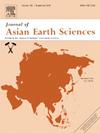Three groups of arthropods (Chasmataspidida, Offacolidae (?), and Euthycarcinoidea) cohabited a tidal zone in the late Cambrian paleobasins (495–488 Ma) of Eastern Siberia
IF 2.7
3区 地球科学
Q2 GEOSCIENCES, MULTIDISCIPLINARY
引用次数: 0
Abstract
We examined arthropods from a newly discovered location, Kimiltei, in the Irkutsk region of Eastern Siberia. These arthropods belong to three distinct groups: basal euchelicerate (putative Offacolidae), Chasmataspidida, and Euthycarcinoidea. They were found together in a single bed. Chemical, mineralogical, and facial analyses revealed that this bed was formed within a very shallow lagoonal/tidal environment with nearby paleosols. Using the combined data, we present a taphonomic model explaining the uncompressed, three-dimensional preservation of the arthropods. Based on U-Pb isotopic dating of detrital zircon grains, we determined the age of this bed as 491.3 ± 4.2 Ma, placing it in the Furongian Series (Jiangshanian and Stage 10). Given this age, the arthropods from Kimiltei appear to be among the earliest known body fossils of Euthycarcinoidea and euchelicerates. An updated analysis of the geographical distribution of these groups indicates that by the late Cambrian, Euthycarcinoidea already had a wide distribution in tropical and possibly boreal regions of the Iapetus Ocean, while euchelicerates inhabited a tropical Siberian paleobasin. The evolution of these groups proceeded at the beginning in close ecological niches in a tidal zone.
求助全文
约1分钟内获得全文
求助全文
来源期刊

Journal of Asian Earth Sciences
地学-地球科学综合
CiteScore
5.90
自引率
10.00%
发文量
324
审稿时长
71 days
期刊介绍:
Journal of Asian Earth Sciences has an open access mirror journal Journal of Asian Earth Sciences: X, sharing the same aims and scope, editorial team, submission system and rigorous peer review.
The Journal of Asian Earth Sciences is an international interdisciplinary journal devoted to all aspects of research related to the solid Earth Sciences of Asia. The Journal publishes high quality, peer-reviewed scientific papers on the regional geology, tectonics, geochemistry and geophysics of Asia. It will be devoted primarily to research papers but short communications relating to new developments of broad interest, reviews and book reviews will also be included. Papers must have international appeal and should present work of more than local significance.
The scope includes deep processes of the Asian continent and its adjacent oceans; seismology and earthquakes; orogeny, magmatism, metamorphism and volcanism; growth, deformation and destruction of the Asian crust; crust-mantle interaction; evolution of life (early life, biostratigraphy, biogeography and mass-extinction); fluids, fluxes and reservoirs of mineral and energy resources; surface processes (weathering, erosion, transport and deposition of sediments) and resulting geomorphology; and the response of the Earth to global climate change as viewed within the Asian continent and surrounding oceans.
 求助内容:
求助内容: 应助结果提醒方式:
应助结果提醒方式:


